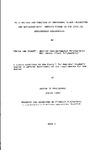THE STRUCTURE AND FUNCTION OF PERIPHERAL BLOOD LEUCOCYTES AND GUT-ASSOCIATED LYMPHOID TISSUE IN THE CICHLID, OREOCHROMIS MOSSAMBICUS
| dc.contributor.author | DOGGETT, TERESA ANN | |
| dc.contributor.other | School of Biological and Marine Sciences | en_US |
| dc.date.accessioned | 2013-11-20T14:19:59Z | |
| dc.date.available | 2013-11-20T14:19:59Z | |
| dc.date.issued | 1989 | |
| dc.identifier | NOT AVAILABLE | en_US |
| dc.identifier.uri | http://hdl.handle.net/10026.1/2776 | |
| dc.description.abstract |
The peripheral blood of O.mossambicus was examined using light and electron microscopy and was found to contain four forms of leucocytes: lymphocytes, thrombocytes, monocytes and three types of granulocytes. The monocyte and two types of granulocyte were found to be phagocytic and ingest colloidal carbon and bacteria. The alimentary tract was found to contain a number of leucocytes, some showing a morphological similarity to those in the peripheral blood, while others were unique to the gut tissue. These intestinal leucocytes were found mainly as a diffuse cell population in the epithelium and lamina propria, and only occasionally as discrete lymphoid accumulations within the gut tissue. Ontogenic studies showed that a limited number of leucocytes were found in the gut tissue after hatching, however, there was a gradual increase in these numbers once exogenous feeding began. The intestinal enterocytes of both the anterior and posterior intestine were found to take up intubated macromolecules. An electron microscopical investigation revealed that these macromolecules were absorbed by pinocytosis and were found within large intraepithelial macrophages. These macromolecules were also absorbed and transported into the systemic circulation. In juvenile fish macromolecules were detected in the plasma following both oral and anal intubation, however, in adult fish they were detected in the plasma only after anal intubation, and in smaller quantities. Macromolecular absorption in O.mossambicus was compared to that in two other fish species, Cyprinus carpio and Sa1mo gairdneri, and it was found that higher levels of absorbed macromolecules were found in the plasma of O.mossambicus. Bovine serum albumin absorption by the gut of the three species revealed that both the 'intact' macromolecule and smaller antigenic fragments, probably resulting from enzymatic modification, were ansorbed and transported into the plasma. | en_US |
| dc.description.sponsorship | Wellcome Laboratories, Beckenham | en_US |
| dc.language.iso | en | en_US |
| dc.publisher | University of Plymouth | en_US |
| dc.title | THE STRUCTURE AND FUNCTION OF PERIPHERAL BLOOD LEUCOCYTES AND GUT-ASSOCIATED LYMPHOID TISSUE IN THE CICHLID, OREOCHROMIS MOSSAMBICUS | en_US |
| dc.type | Thesis | |
| plymouth.version | Full version | en_US |
| dc.identifier.doi | http://dx.doi.org/10.24382/4905 | |
| dc.identifier.doi | http://dx.doi.org/10.24382/4905 |
Files in this item
This item appears in the following Collection(s)
-
01 Research Theses Main Collection
Research Theses Main


